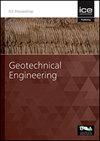A novel methodology for geometry assessment of self-drilling micropiles using distributed fiber optic sensors
IF 1.7
4区 工程技术
Q3 ENGINEERING, GEOLOGICAL
Proceedings of the Institution of Civil Engineers-Geotechnical Engineering
Pub Date : 2024-03-16
DOI:10.1680/jgeen.23.00113
引用次数: 0
Abstract
Self-drilling micropiles (SDM) are gaining popularity as bearing foundation elements, as this construction technique allows for considerable time and cost savings. However, the irregular geometry and variability in the bearing capacity present uncertainty and a significant risk that has limited SDM deployment. To date, no reliable technology has been used to measure the SDM geometry. This paper proposes a methodology that uses distributed fiber optics (DFO), heat conduction modeling, and inverse analysis to measure the pile geometry and could also be extended to assess its bearing capacity. The temperature distribution during cement hydration was measured using two DFO investigative technologies and was compared to traditional temperature measurements using point sensors. An inverse analysis of SDM geometry was subsequently carried out based on the DFO measurement of temperature a finite element (FE) heat conduction model and a calibration pile. Finally, the calculated pile geometry was compared to the geometry of excavated pile in the uppermost part. The methodology presented here is not only intended as a tool for designing SDMs but can also be deployed as a structural health monitoring system to detect and monitor crack formation.利用分布式光纤传感器评估自钻微桩几何尺寸的新方法
自钻微桩(SDM)作为承载地基构件越来越受欢迎,因为这种施工技术可以节省大量时间和成本。然而,不规则的几何形状和承载能力的可变性带来了不确定性和重大风险,限制了 SDM 的应用。迄今为止,还没有可靠的技术用于测量 SDM 的几何形状。本文提出了一种方法,利用分布式光纤(DFO)、热传导建模和反分析来测量桩的几何形状,并可扩展到评估其承载力。使用两种 DFO 调查技术测量了水泥水化过程中的温度分布,并与使用点传感器的传统温度测量方法进行了比较。随后,根据 DFO 测量温度、有限元 (FE) 热传导模型和校准桩,对 SDM 的几何形状进行了反分析。最后,将计算出的桩的几何形状与最上部挖掘出的桩的几何形状进行比较。本文介绍的方法不仅可作为设计 SDM 的工具,还可作为结构健康监测系统,用于检测和监测裂缝的形成。
本文章由计算机程序翻译,如有差异,请以英文原文为准。
求助全文
约1分钟内获得全文
求助全文
来源期刊
CiteScore
4.40
自引率
4.50%
发文量
68
审稿时长
3 months
期刊介绍:
Geotechnical Engineering provides a forum for the publication of high quality, topical and relevant technical papers covering all aspects of geotechnical research, design, construction and performance. The journal aims to be of interest to those civil, structural or geotechnical engineering practitioners wishing to develop a greater understanding of the influence of geotechnics on the built environment.

 求助内容:
求助内容: 应助结果提醒方式:
应助结果提醒方式:


